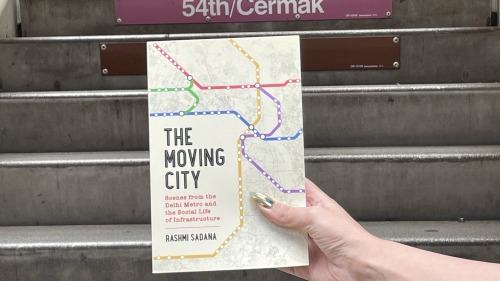Rashmi Sadana Explores the Social Impact of the Delhi Metro

The Pattis Family Foundation Global Cities Book Award finalist discusses how infrastructure like transit impacts the daily lives of city residents.
In August 2023, the Council announced the six-title shortlist for the inaugural 2023 Pattis Family Foundation Global Cities Book Award, which celebrates books that deepen our understanding of the role cities play in addressing critical global challenges. Over the coming weeks, we’ll be sharing interviews with the shortlisted authors discussing their books and the pressing issues facing cities today.
Rashmi Sadana’s The Moving City: Scenes from the Delhi Metro and the Social Life of Infrastructure is the story of how the Delhi Metro reshaped the city’s social and urban landscape and is a commentary on infrastructure and the importance of the physical and emotional impact of public transportation on those who use it.
Sadana is associate professor of anthropology at George Mason University and the author of English Heart, Hindi Heartland: The Political Life of Literature in India. She recently joined us for a conversation on the influences of her book. The author’s responses have been lightly edited.
Q: Cities are not just places but are becoming actors in shaping local and international policy. What lessons do you hope other cities take away from your book?
A: I hope other cities see that public transport is vital for social mobility and a cleaner planet, but that capital intensive, mega-infrastructure projects alone are not a simple answer to the desire for a “world-class city.” If the goal is greater equality and not only upward mobility for those who already have some, people from all backgrounds and parts of the city must be able to have access to transit and afford to get to where they want to go. This kind of equity begins in the urban development discourse itself, which can be very technocratic and classist. My book shows the symbolic power and importance of Delhi’s Metro for those who ride it, as well as the inclusions and exclusions embedded in the system. It’s for this reason that I claim that Delhi’s Metro is a talisman, albatross, and jewel.
Q: What is the greatest challenge facing cities today and how do cities move forward?
A: I would say environmental sustainability and the effects of climate change, from flooding to heat waves. The environment is also about social inequality, who can afford to live where and use what, or be protected or exposed to the elements in varying degrees. Mass transit has a key role to play in virtually every city where private vehicles are proliferating (often because cars are a symbol of having achieved middle class status). Controlling emissions is important, but regulation must be coupled with creating a culture of using public transit for future sustainability. This “culture” is more likely to take hold when people feel they have an affordable and dignified way to travel.
Q: Which book(s) influenced you the most in crafting yours?
A: Wolfgang Schivelbusch’s The Railway Journey was an early influence. It’s a book about how the 19th century railways forever changed the physical landscape and people’s experience of time and space. Paul Virilio’s Speed and Politics made me think about how there is a politics to speed (that accelerates in advanced capitalism), and this politics influences how we conceptualize urban development and engage with a range of actors. In terms of the actual writing of the book, I was influenced by Kathleen Stewart’s Ordinary Affects which, like my book, employs the vignette structure to put scenes from everyday life in contrast with one another and to relay the emotional impact of social realities and specific cultural milieus. I want my readers not only to understand the arguments in my book but also to sense and feel them by engaging with the mundane and dramatic scenes of daily metro travel.
Q: What area of study did you intend your book to contribute to, and why did you choose that topic to write on?
A: I intended my book to contribute to anthropology/sociology and related fields such as urban studies, global studies, technology studies, cultural studies, and gender studies. I chose the topic of Delhi’s Metro because I knew from the start (in the mid-2000s) that the system would have an enormous impact on people’s lives and the urban landscape. I also knew the metro was going to be a game changer for women, in particular, who had new license to the city because of the metro’s secure and well-lit environment. So, the book became a study of the social impact of the Delhi Metro, achieved through 4,000 hours of interviews and participant observation on the trains with metro riders and in offices with urban planners, architects, metro officials, transport activists, and politicians.
Q: What are you trying to achieve with your book?
A: I want readers to experience the urban life that I showcase to understand key issues around urban development, and to see connections between a city like Delhi and the rest of the world. People everywhere in the world want to experience social mobility and the dignity of safe and affordable transit. Infrastructure is about massive construction and global expertise, but it is also an intimate social space that intersects with people’s hopes and aspirations. My book aims to draw readers into the sometimes incongruent but always illuminating juxtapositions that mega-infrastructure creates in cities.



